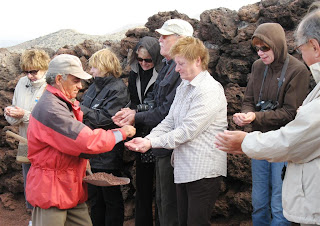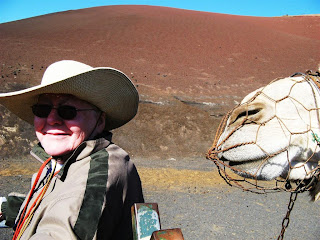We docked just at dawn at the Port of Arrecife. The town name means "Reef" just like the same named city in Brazil. (I just said that to impress you.) Arrecife is the only big city, so to speak, on the most north and east island in the chain, only 100 miles west or so from mainland of Africa. In Corfu last year we watched a dog assist the line handlers as the ship docked. In Arrecife they used a truck. So I knew this port call would be special.
Fire Mountains National Park
Actually, this stop was special big time. To call Lanzarote volcanic is like calling China populous. Even one of the Hawaiians on board this cruise segment--there are 40 or so of them from the same travel agency that books often with Silversea--said, "We're not in Kansas anymore." (I complimented him on his perception and then ran away.) Lanzarote is an island that nobody SHOULD live on. It looks unstable and is unstable. The "geology professor" lecturer onboard--who started his briefing with "I won't include any of that big science stuff" and whose CV says he "took a degree" in geology and then was a faculty member at "a big university, lecturing in GIS"--said that this island was the oldest island in the Canaries geologically. But to me the lack of rain makes it look brand new.
The towns are brand new as well as far as I can tell. The building code on the entire island specifies strange looking but appealing little white housing developments, and except for downtown Arrecife we saw nothing else in each settlement. The major purpose for this visit was to take a half day tour of the unbelievable, fantastic, overwhelming, and spectacular (did I have a good time, or what?) Montanas del Fuego National Park which covers the western part of the island. We drove up to about 2000 feet and stopped for a demonstration of volcanoes, something that would drive Madame Pale to destroy the entire place in a minute. That is, the ever enthusiastic docents at the park first shoveled up some hot pebbles and deposited them in the cupped hands of each of us ever gullible tourists. My, my, those pebbles were hot. Then a guy thrust a small bush into a hole in the lava and the bush burst into flame, but the best part of the demo was when the guide poured a bucket of water into a hole in the ground. He ran away like hell and then a big burst of steam came out the hole (and not up somewhere else, as I was running far away at the time for fear of that happening.) As I said, even the Hawaiians get spooked by all this. Later, one of them told me that Madame Pale can be appeased with gin. As the big drink in Lanzarote is wine from the locally grown Malvasia gapes which tastes like lava, as I learned at a thankfully short wine tasting latter in the tour and not gin, the demo at the volcano just got be nervous.
Well, not as nervous as the big bus on the very narrow road through the Fire Mountains and then the dromedary ride. Actually the one-humped camel ride wasn't all that bad, if you don't mind the following camel sniffing up your behind or worse (?), and much better than walking on the same paths, if you know what I mean.
We then stopped at the above mentioned winery and sampled the two wines produced only in Lanzarote. The sweet one was very bad, and the dry one was really bad. See, I have developed quite a palate. The guide said that the wines "have the taste of lava." Apparently, lava is yucky. But the winery stop was worth doing for the close up view of the unique method of irrigation used on this essentially rain free place. The local farmers have learned to "harvest" the substantial local dew by building small walls of lava rocks--boy do they get these cheap around here--and planting each vine in a small indentation in the soil. The rocks cool faster each night than the soil and therefore condense the fog which pools around each plant. It really works, but as I said the wine tastes funny. Oh well, 'wine' a few, lose a few.
Arriciffe Town
We had a quick lunch on board the ship and then took the frequent shuttle bus into the capital city of Lanzarote. Despite the quite appealing shops being closed, it was a worthy way to spend an hour's walk. We looked at the waterfront and a sculpture made from lava rocks--hey, they do what they can here--and even the pretty harbor being developed for small boats. Apparently, the local town fathers haven't read the complete instructions that water is needed for a successful harbor. The boats were pretty though, and you could get a close up picture without getting your feet wet.
We sailed at 5 pm for the 250 mile bumpy ride back to the mainland of Africa and Agadir, Morocco.














No comments:
Post a Comment